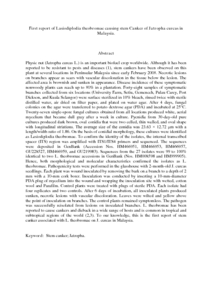Citation
Sulaiman, Roslina and Sri Thanarajoo, Sathis and Kadir, Jugah and Vadamalai, Ganesan
(2012)
First report of Lasiodiplodia theobromae causing stem Canker of Jatropha curcas in Malaysia.
Plant Disease, 96 (5).
p. 767.
ISSN 0191-2917
Abstract
Physic nut (Jatropha curcas L.) is an important biofuel crop worldwide. Although it has been reported to be resistant to pests and diseases (1), stem cankers have been observed on this plant at several locations in Peninsular Malaysia since early February 2008. Necrotic lesions on branches appear as scars with vascular discoloration in the tissue below the lesion. The affected area is brownish and sunken in appearance. Disease incidence of these symptomatic nonwoody plants can reach up to 80% in a plantation. Forty-eight samples of symptomatic branches collected from six locations (University Farm, Setiu, Gemenceh, Pulau Carey, Port Dickson, and Kuala Selangor) were surface sterilized in 10% bleach, rinsed twice with sterile distilled water, air dried on filter paper, and plated on water agar. After 4 days, fungal colonies on the agar were transferred to potato dextrose agar (PDA) and incubated at 25°C. Twenty-seven single-spore fungal cultures obtained from all locations produced white, aerial mycelium that became dull gray after a week in culture. Pycnidia from 30-day-old pure cultures produced dark brown, oval conidia that were two celled, thin walled, and oval shape with longitudinal striations. The average size of the conidia was 23.63 × 12.72 μm with a length/width ratio of 1.86. On the basis of conidial morphology, these cultures were identified as Lasiodiplodia theobromae. To confirm the identity of the isolates, the internal transcribed spacer (ITS) region was amplified with ITS1/ITS4 primers and sequenced. The sequences were deposited in GenBank (Accession Nos. HM466951, HM466953, HM466957, GU228527, HM466959, and GU219983). Sequences from the 27 isolates were 99 to 100% identical to two L. theobromae accessions in GenBank (Nos. HM008598 and HM999905). Hence, both morphological and molecular characteristics confirmed the isolates as L. theobromae. Pathogenicity tests were performed in the glasshouse with 2-month-old J. curcas seedlings. Each plant was wound inoculated by removing the bark on a branch to a depth of 2 mm with a 10-mm cork borer. Inoculation was conducted by inserting a 10-mm-diameter PDA plug of mycelium into the wound and wrapping the inoculation site with wetted, cotton wool and Parafilm. Control plants were treated with plugs of sterile PDA. Each isolate had four replicates and two controls. After 6 days of incubation, all inoculated plants produced sunken, necrotic lesions with vascular discoloration. Leaves were wilted and yellow above the point of inoculation on branches. The control plants remained symptomless. The pathogen was successfully reisolated from lesions on inoculated branches. L. theobromae has been reported to cause cankers and dieback in a wide range of hosts and is common in tropical and subtropical regions of the world (2,3). To our knowledge, this is the first report of stem canker associated with L. theobromae on J. curcas in Malaysia.
Download File
![[img]](http://psasir.upm.edu.my/23638/1.hassmallThumbnailVersion/First%20report%20of%20Lasiodiplodia%20theobromae%20causing%20stem%20Canker%20of%20Jatropha%20curcas%20in%20Malaysia.pdf)  Preview |
|
PDF (Abstract)
First report of Lasiodiplodia theobromae causing stem Canker of Jatropha curcas in Malaysia.pdf
Download (155kB)
| Preview
|
|
Additional Metadata
Actions (login required)
 |
View Item |

